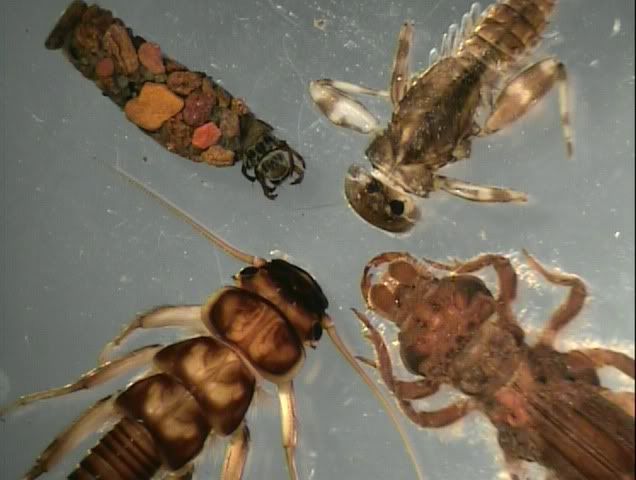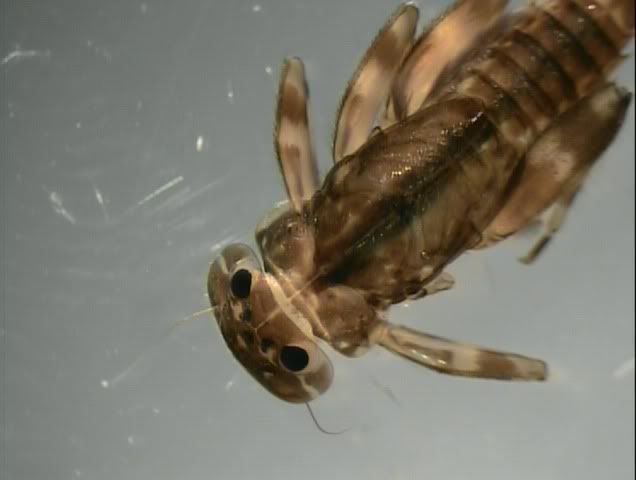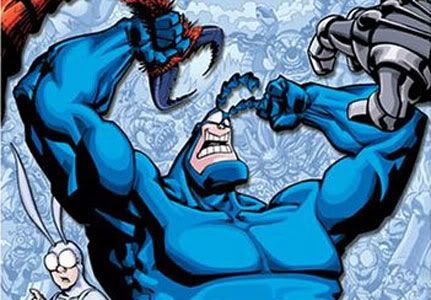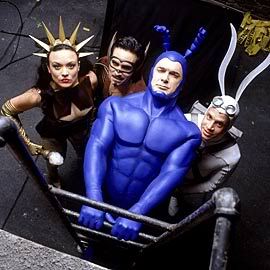Ento-musings from the University of Kentucky Department of Entomology
Monday, December 21, 2009
Spiders vs. Gators
Kentucky basketball fans received even MORE good news this weekend, when the Richmond Spiders defeated the Florida Gators:
http://www.tampabay.com/sports/basketball/college/florida-gators-stunned-by-richmond-spiders-56-53/1060177
This is good news, of course, because U of KY fans always cheer when a U of Florida team drops a game. In fact, for many UK fans, especially basketball fans, the UK-v-Florida rivalry status falls somewhere between UK-v-Tennessee and UK-v-Duke... and that's rivalrous, folks. Go Cats!
I also realized during the Spiders-vs-Gators game (yes, I watched it just to see Florida lose) that I couldn't think of very many other college teams that have an arthropod as a mascot. This doesn't seem right, especially since arthropods (that's insects, spiders, and their relatives) account for, according to some informal estimates, about 75% of all animal species.
So... below I listed all of the college teams that I could find with an arthropod as a mascot. Can anyone else find any others? What about pro, semi-pro, high-school, or little-league???
University of Richmond - Spiders
Georgia Tech - Yellow Jackets
U of Texas at Brownsville - Scorpions
St. Ambrose University (Iowa) - Fighting Bees
Sacramento State - Hornets
Alabama State - Hornets
Black Hills St (S. Dakota) - Yellow Jackets
Montana St - Yellow Jackets
University of Wisconsin-Superior - Yellow Jackets
Cedarville University (Ohio) - Yellow Jackets
I also found the University of Rochester "Yellow Jackets," a college singing group. They wear yellow jackets while singing, apparently.
Oh, and by the way: sport's-rivalies aside, the University of Florida has one of the best entomology departments in the U.S. In fact their Featured Creatures website was one of the primary inspirations for our KY Critter Files site.
Tuesday, December 15, 2009
Climate Science and Entomology
With the recent controversy involving hacked emails and scientific conspiracies, climate science is getting even more attention than usual. This reminded me that, over the last decade or so, entomologists have played a small roll in gathering some of the data related to climate-change. In fact, one of our own scientists at the University of Kentucky Department of Entomology, Dr. Janet Lensing, conducted research in this area about 5 years ago. She examined the impact of drought conditions on a forest-floor ecosystem (an insect-and-spider-heavy environment). Here is an article from the NY Times in 2006, summerizing her results:
http://www.nytimes.com/2006/10/03/science/03observ.html
And here is another article that summarizes climate/insect research from Penn State University:
http://www.collegian.psu.edu/archive/2008/02/26/study_observes_insects_to_expl.aspx
Studies like these underscore one of the reasons why entomology is such an important science: because insects are small and because they have relatively short life-cycles, they make excellent subjects for observation. In climate studies, for instance, the effects of drought and temperature on multiple generations of insect populations can be observed within a couple of seasons, or, in some cases, months or weeks. In contrast, it can take decades to study similar effects on mammal, fish, or plant (or human!) populations.
So, as the climate-change debate continues, I'm confident that entomologists will be involved. It's good to have job security!
Thursday, December 10, 2009
Tattoo Taboo: Insect body art
I find tattoos intrinsically interesting. As an Entomologist, I find insect tattoos compelling for a number of reasons. I cannot think of a more difficult subject - there are legs and antennae, and sometimes mouthparts - these features can get all jumbled up to make the tattoo seem uninterpretable. Insect anatomy is also something that needs to be researched in order to get all the body parts correct (the number of legs, the legs should come from the thorax, ect). Also, to do an insect tattoo well it probably needs to be a bit large. The difficulty this presents is that any background or additional subjects can be disproportional. There is also a good bit of technical skill required - it is not easy to have a fuzzy bee that doesn't come across as blurry instead.
With this in mind I found a few images that illustrate what I mentioned above. I write this to point out details that might otherwise go unnoticed, and to share my appreciation for skilled art.


I picked this image to contrast the one above. Note the solid black outline of the beetle. Also, to separate the beetle from the shadow, there is a thin break of "white" between the beetle and shadow (the white here is probably skin tone).

Something about this just catches my eye. The foreground is outlined in black, and the background is not. Notice the fly has ocelli! Also, I like how the closed fly-trap has the shadow of a fly within it. The colors are vivid, and contrast so that there is no doubt what you are looking at.

This is from the same artist as above, and the composition is fantastic. The arrangement of the legs keep it from looking crowded. There are probably some liberties taken with the green stripes and legs, but the overall anatomy is good even though stylized a bit. The petals near the head are not outlined, and that helps make the head stand out as a focus. The whole piece seems to blend with the background and separate equally well.

The attention to detail here is second to no other tattoo I've seen. It helps that the tattoo is big, and that the entire insects are not in it.

Nick Baxter is one of few artists I know by name and admire. His overall compositions are some of best. He uses the background to contrast the subjects, and does a good job of making the bee appear fuzzy without being blurry. The background is detailed, but doesn't take over the subjects.
Well, I hope that you enjoyed reading this and maybe picked a thing or two to notice about any tattoos you encounter in the future.
Tuesday, December 8, 2009
Parasitic Wasps (UK Entomology Seminar: Dec 4, 2009, Andy Boring)
Every week, usually on Friday afternoon at 3pm, our department hosts a seminar. Last week, on Dec 4, Andy Boring was our speaker. Andy is a graduate student in Dr. Sharkey's laboratory. This was his exit seminar, and it was fascinating!
As a PhD student, Andy studied parasitic wasps in the scientific family Braconidae. Parasitic wasps are a little different than the wasps that most of us know. Parasitic wasps do not sting people. Instead, they sting other insects (& sometimes other arthropods, like spiders). When they do so, they place an egg, or multiple eggs, inside the host-insect's body. The eggs hatch and the larvae feed on the host, eventually killing it (yes, Alien from the movies WAS reportedly based on parasitic wasps!). This is common in the insect world: there are thousands of species of parasitic wasps, and each lays its eggs in a different type of insect.
A portion of Andy's PhD research focused on the ovipositors of parasitic wasps. Ovipositors are egg-laying devices found on the abdomens of many female insects. In parasitic wasps, the ovipositors are often long and thin--prefect for stinging small hosts. For many years, the mechanism of wasp oviposition was poorly understood. Andy's research was so interesting because he spent many hours dissecting these tiny stingers (they are thinner than needles!) and examining all of the internal structures. As it turns out, the ovipositors that Andy studied were made of three primary longitudinal sections. In other words, an ovipositor is actually three long, flexible segments that fit closely together to form a tube (imagine reassembling a banana from an empty peel!). Also located inside the tube is a series of small one-way valves that help to move the egg down--but not up--the ovipositor. And, when many parasitic wasps sting a host, they also inject venom and other fluids. Because of this, many ovipositors possess anatomical structures that facilitate the delivery of these fluids.
During his time here, Andy studied a bunch of other cool stuff about wasps as well. In particular, he discovered and named several different wasp species. This is actually quite common: Dr. Sharkey's students frequently discover and name new species of wasps. If you a interested in becoming a scientist, and if you want the thrill of discovering new species, entomology is the place to be. New insect species are being discovered ALL THE TIME. Hey Andy: if you see this post, can you write a follow-up post showing the total number of species that you named? UPDATE (12/10/09): Andy wrote a comment below about the insects that he named. Be sure to read it!
To learn more about wasp research in the Sharkey lab, visit the UK Hymenoptera Institute website. And you can learn more about our (free!) weekly seminar series here.
Thursday, December 3, 2009
Benthic Macroinvertebrates

I've always been fascinated by benthic macroinvertebrates. I used to catch crayfish and mayflies and stoneflies in the creeks behind my house when I was little. Even now, I think it's fun to watch them crawl around on rocks, or beat their gills, or bravely arch their tails over their backs, ready for combat (or at least try to look scary).

It's hard to imagine mayflies, like this one, intimidating anything. There are some other families, however, which have some mean looking tusks! They're probably more for digging in a creek bed than for combat, though. More pictures to follow (these aren't the greatest, but I'm learning how to use the microscope camera in the lab).
In a few short weeks, I'll be presenting some preliminary results from the first year of my research project at the national Entomological Society of America meeting in Indianapolis. I am interested in determining the differences between benthic macroinvertebrate communities dwelling in streams surrounded by eastern hemlock versus streams with deciduous riparian zones. As you may know, eastern hemlock is being threatened by the exotic invasive Hemlock Woolly Adelgid. Because it is an evergreen tree eastern hemlock creates localized stable conditions, such as temperatures and stream base flows, all year long. I'm interested in what might happen to the stream biota of hemlock-supported headwater streams, if widespread mortality of eastern hemlock were to take place in the mountains of Eastern Kentucky.
That's a scary thought!
Until next time,
-Josh-
Tuesday, December 1, 2009
Arthopod-inspired Super Heroes - Part One
While most people think immediately of Spider-Man when considering arthropod inspired costumed vigilantes, there are others who have taken up the mantle of Arthropoda in order to uphold the law/defend the defenseless/mete out justice/generally wreak havoc.
For my first entry in this (potentially never-ending) series exploring arthropods in comic books, I will feature The Tick.

In the original comic books, The Tick is apparently legally insane, having escaped from a mental institution located not too far from The City. Perhaps best known for the damage he causes leaping from rooftop to rooftop, and his nonsensical battle cry "SPOON!", The Tick's powers include nigh-invulnerability, super strength, and "drama power", which heightens his super powers as the scene becomes more dramatic. While he is often responsible for extensive collateral damage in his battle against evil, and although his speeches never really make much sense, The Tick always means well.
The Tick has come into conflict with a number of ne'er-do-wells during his tenure as champion of The City. Some of them include:

The Man Eating Cow. Born a normal cow, she was trained to eat people. Once conspired with The Terror's League of Evil to kidnap the Mayor of The City in a plot to eventually rule the world.

Multiple Santa. A bank robber who steals a Santa suit to elude the police. An unfortunate incident involving a mass electrical charge from a neon sign somehow gives him the ability to produce clones of himself, fueling a City-wide rampage!

Chairface Chippendale. A debonair, educated, and powerful crime boss, who has a chair for a head. The Tick once foiled his plan to write his name on the moon with a giant laser!

There was a short lived live-action television series that aired on Fox in 2001, starring Patrick Warburton as The Tick (fellow Seinfeld fans might know him best as Elaine's on-again-off-again boyfriend David Puddy). His take on the character:
"His past is a mystery. So everything that he looks at or perceives can be brand new, and he can get really, really excited and intrigued by something that’s just a commonality for everybody else, that’s humorous. He’s like a child; everything’s new. So you just bring that attitude to him, a childlike attitude of discovering things."
A general description of the series from Wikipedia: "The Tick was tricked into moving to (and protecting) The City after irritating the employees of a remote bus station he had sworn to protect." Only nine episodes were produced, because as always execs at Fox rarely know when they have a good thing going (see Firefly for further proof). I think this show is hilarious! Fortunately, the entire series has been released on DVD, and is available to watch on YouTube. You can watch the pilot by clicking here. Really great stuff.
Until next time, true believers!
-Josh-
Dengue Outbreak
Dengue epidemic paralyzes Cape Verde
A first-ever outbreak of dengue fever in Cape Verde, already causing four deaths and infecting 9,000 people, has caused widespread panic on the archipelago. Tomorrow, everyone in the infected area is urged to kill mosquitoes instead of going to work. Both the police and army have been recruited to root out the cause of the disease.
The full article can be found here:
http://www.afrol.com/articles/34631
Insect nostalgia: Ranger Rick and "critter keepers"
 d like me. It's like Animal Planet and Kratt's Creatures combined! Looking at them today, my old magazine issues from the late 80's and early 90's seem ahead of their time in teaching conservation, science, and a love of nature to young children. The magazine, sponsored by the National Wildlife Federation, is still going strong- you can skim through a current issue here (you need a Flash player to view). Check out the grasshopper on page 5 and the aquatic spider on page 6--- yes, an aquatic spider! The Diving Bell Spider, Argyroneta aquatica, is the only spider species known to spend its entire life below the water. It can be found in weedy streams and ponds in northern and central Europe, where it hunts and feeds on aquatic invertebrates and prey as large as tadpoles and minnows! The spider breathes by carrying its own oxygen supply in the form of a thin layer of air held close to the body with small hairs, plus keeping a large bubble of air in their underwater, bell-shaped web (see photo).
d like me. It's like Animal Planet and Kratt's Creatures combined! Looking at them today, my old magazine issues from the late 80's and early 90's seem ahead of their time in teaching conservation, science, and a love of nature to young children. The magazine, sponsored by the National Wildlife Federation, is still going strong- you can skim through a current issue here (you need a Flash player to view). Check out the grasshopper on page 5 and the aquatic spider on page 6--- yes, an aquatic spider! The Diving Bell Spider, Argyroneta aquatica, is the only spider species known to spend its entire life below the water. It can be found in weedy streams and ponds in northern and central Europe, where it hunts and feeds on aquatic invertebrates and prey as large as tadpoles and minnows! The spider breathes by carrying its own oxygen supply in the form of a thin layer of air held close to the body with small hairs, plus keeping a large bubble of air in their underwater, bell-shaped web (see photo). "critter keeper." This is the bug-loving kid's best friend- constructed out of wood and mesh, with a swinging door, it can house all types of creepy crawlies without Mom being too worried about an escape. Most of the marketed critter keepers (and the brand name Kritter Keeper) are made of plastic and neon colors, but I prefer the old style pictured above (and available for purchase from Amazon.com). That one has a rope-like handle, which seems superior to the thin leather strap from my childhood critter keeper, which was re-glued and re-stapled several times because of the abuse it suffered at my hands!
"critter keeper." This is the bug-loving kid's best friend- constructed out of wood and mesh, with a swinging door, it can house all types of creepy crawlies without Mom being too worried about an escape. Most of the marketed critter keepers (and the brand name Kritter Keeper) are made of plastic and neon colors, but I prefer the old style pictured above (and available for purchase from Amazon.com). That one has a rope-like handle, which seems superior to the thin leather strap from my childhood critter keeper, which was re-glued and re-stapled several times because of the abuse it suffered at my hands!Saturday, November 28, 2009
Lunesta: Lime-Green Moth, Red-Hot Controversy
Insects and spiders are often used in popular culture. They demand attention when they appear in movies, TV shows, billboards, etc. Sometimes, though, the depictions aren't 100% accurate. Over the Thanksgiving break I noticed that the moth featured in the one of the current Lunesta television commercials is not... quite... right.
Presumably, the creature in the commercial is meant to be a luna moth (although I cannot confirm this on the company's website). The luna moth is one of the largest moths in North America. It is native (and common in Kentucky) and is distinguished by its hairy, lime-green body and its long, tailed wings. At first glance, the Lunesta moth looks very much like a luna moth. The color is right. So are the markings. Heck, I think even the wing-venation is correct. But there is a fundamental error in the Lunesta mascot: luna moths do not have knobbed antennae. In fact, in most cases, only butterflies (and their relatives, the skippers) have truly knobbed antennae. The antennae of moths are typically long and straight, or feathery. This is one of the main distinctions between moths and butterflies (the Butterflies and Moths of North America website discusses some other differences as well).
Okay, so the mascot's antennae aren't perfect. I guess that's not a big deal. But while researching this topic I found that there is another controversy surrounding the Lunesta moth. John Mack, a marketing blogger, found evidence that the moth's presence in TV ads has been reduced. He thinks its because of negative marketing and maybe because the moth's "eerie glow" is a bit "frightening." Cool!
Read more about the luna moth and its relatives, the Giant Silkworm Moths, in our UK Entomology factsheet, written by Dr. Ric Bessin: Saturniid Moths.
Tuesday, November 24, 2009
Moth Featured at Cute Overload
Insects are often pests and they are always invertebrates. Seldom, though, are they cute. So it is newsworthy that a Rosy Maple Moth (a Kentucky native) was recently featured on the popular website, Cute Overload:
http://cuteoverload.com/2009/10/17/if-elvis-returned-as-a-moth/
Be Thankful for Tobacco Hornworms
From the book The American Turkey by Andrew Smith, and sent to me this morning by a fellow entomologist here at UK:
"By far the most important reason for the growth of the domesticated turkey population in America, particularly in Virginia and Maryland, was tobacco. Tobacco was America's first agribusiness and preeminent colonial export. A major challenge in growing the crop was to control tobacco hornworms (Sphinx carolina)...In a time before pesticides and other deterrents, planters were helpless to fight hornworm infestation....To the rescue came the turkey, an omnivore that loves to feast on insects and bugs and finds the large and meaty tobacco worm irresistible. By the mid-eighteenth century planters were sending turkeys into their tobacco fields to eat worms...Fifty turkeys could handle an estimated hundred thousand worms if properly managed." The turkeys then became Thanksgiving dinners in the South, and the tradition grew from there!
Emerald Ash Borer Control
I saw for the first time today a truck in Lexington, Ky, advertising "emerald ash borer control." It was a professionally printed magnet-style sign and the truck was owned by a local landscaping company. So the ash borer has officially bored into our pocketbooks here in the Bluegrass.
